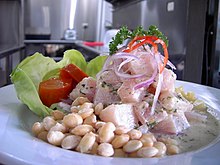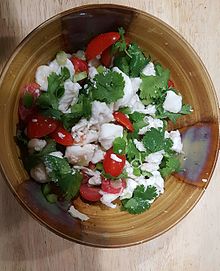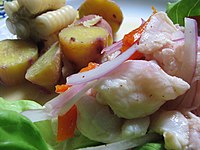User:MarshalN20/Sandbox2
 Peruvian ceviche | |
| Course | Main course, appetizer |
|---|---|
| Place of origin | Peru |
| Main ingredients | Seafood, lime or lemon |
| Other information | Cooked or marinated (raw) |
Ceviche is a seafood dish of Peruvian origin that is typical of Latin American cuisine. Its name is possibly derived from either the Quechua word for "fresh fish" (siwichi) or the Andalusian Arabic word for "meat cooked in vinegar" (assukkabáǧ). The dish primarily consists of seafood that is marinated in citrus juice. Additional ingredients and garnishes vary throughout Latin America, the exact recipe depending on local culinary traditions.
Scholars and renown chefs agree that ceviche was invented in colonial Peru, with the arrival of citrus fruits and onions from the Columbian exchange in the 16th century. In pre-Columbian Peru, indigenous civilizations, reliant on marine resources from the highly-productive Humboldt Current ecosystem, marinated seafood using the fermented juices (known as chicha) from cultigens and wild plants such as the banana passionfruit. The oldest-known mention of the dish in the historical record dates to 1820, when "seviche" is mentioned as a food in "La Chicha," a Peruvian patriotic song advocating the country's independence from Spain.
Ceviche is served as either an appetizer or a main dish. Because the dish is eaten raw, meaning not cooked with heat, it must be prepared fresh and consumed immediately to minimize the risk of food poisoning. As part of the Nuevo Latino gourmet culinary trend, ceviche has been increasingly popular in the United States since the early 1990s. Due to the dish's historical significance, Peru decreed a national cultural heritage law instating ceviche as a "Cultural Patrimony of the Nation" in 2004. Peru celebrates a yearly public holiday in honor of the dish on June 28.
Etymology
[edit]The first documented evidence of the term "Ceviche" is from 1820, in the song "La Chicha", sung by Peruvian soldiers.
According to the Royal Spanish Academy, ceviche has the same etymology as the Spanish term escabeche, which derives from Mozarabic izkebêch, in turn descending from Andalusian Arabic assukkabáǧ, which also derives from Classical Arabic sakbāj (سكباج, meaning meat cooked in vinegar).[1][2] It is ultimately from the unattested Middle Persian *sikbāg, from sik ("vinegar")[3] and *bāg ("soup"), which also yielded the Persian word sekbā (سکبا, a soup made with meat and vinegar).[4] Further hypotheses base the origin of the term on escabeche, Spanish for pickle, or it is simply a variation of the word siwichi.[5]
The name of the dish may be spelled variously as cebiche, ceviche, seviche or sebiche, but the more common spelling in Peru is ceviche, with v which is an alternative spelling accepted by the Royal Spanish Academy,[6][7]. However, other local terms, such as cerbiche and serviche, are still used as variations to name the dish.[8]
History
[edit]
Humans have marinated fish for food preservation since time immemorial.
Various explanations of ceviche's origin exist, with Peruvian nationalism favoring a Pre-Hispanic origin. According to some historic sources from Peru, ceviche originated among the Moche, a coastal civilization that began to flourish in the area of current-day northern Peru nearly 2000 years ago.[9][10] The Moche apparently used the fermented juice from the local banana passionfruit.[9] Recent investigations further show that during the Inca Empire, fish was marinated with chicha, an Andean fermented beverage. Different chronicles also report that along the Peruvian coast prior to the arrival of Spaniards, fish was consumed with salt and ají.[10]
Nevertheless, most historians agree that ceviche originated during colonial times in the area of present-day Peru.[11][12] They propose that the predecessor to the dish was brought to Peru by Andalusian women of Moorish background who accompanied the Conquistadors and that this dish eventually evolved into what nowadays is considered ceviche.[12][13] The Peruvian chef Gastón Acurio further explains that the dominant position that Lima held throughout four centuries as the capital of the Viceroyalty of Peru allowed for popular dishes such as ceviche to be brought to other Spanish colonies in the region and to eventually become a part of local cuisine by incorporating regional flavors and styles.[14]
The Peruvian origin of the dish is widely agreed upon, including the Chilean Christopher Carpentier and the Spaniard Ferran Adrià, who in an interview stated, "Cebiche was born in Peru, and so the authentic and genuine [cebiche] is Peruvian."[15][16]
Preparation and variants
[edit]Ceviche is marinated in a citrus-based mixture, with lemons and limes being the most commonly used. In addition to adding flavor, the citric acid causes the proteins in the seafood to become denatured, appearing to be cooked. (However, acid marinades will not kill bacteria or parasitic worms, unlike the heat of cooking.) Traditional-style ceviche was marinated for about three hours. Modern-style ceviche, popularized in the 1970s, usually has a very short marinating period. With the appropriate fish, it can marinate in the time it takes to mix the ingredients, serve, and carry the ceviche to the table.[17]
Most Latin American countries have given ceviche its own touch of individuality by adding their own particular garnishes.
-
Peruvian ceviche
-
Ecuadorian ceviche, made of shrimp, lemon and tomato sauce
-
Mexican ceviche
-
Ceviche from Costa Rica
South America
[edit]In Peru, ceviche has been declared to be part of the country's national heritage and has even had a holiday declared in its honor.[18] The classic Peruvian ceviche is composed of chunks of raw fish, marinated in freshly squeezed key lime, with sliced onions, chili peppers, salt and pepper. Corvina or cebo (sea bass) was the fish traditionally used. The mixture was traditionally marinated for several hours and served at room temperature, with chunks of corn-on-the-cob, and slices of cooked sweet potato. Regional or contemporary variations include garlic, fish bone broth, minced Peruvian ají limo, or the Andean chili rocoto, toasted corn or cancha and yuyo (seaweed). A specialty of Trujillo is ceviche prepared from shark (tollo or tojo). Lenguado (sole) is often used in Lima. The modern version of Peruvian ceviche, which is similar to the method used in making Japanese sashimi, consists of fish marinated for a few minutes and served promptly. It was developed in the 1970s by Peruvian-Japanese chefs including Dario Matsufuji and Humberto Sato.[19] Many Peruvian cevicherías serve a small glass of the marinade (as an appetizer) along with the fish, which is called leche de tigre or leche de pantera.
In Ecuador, the shrimp ceviche is sometimes made with tomato sauce for a tangy taste. The Manabí style, made with lime juice, salt and the juice provided by the cooked shrimp itself is very popular. Occasionally, ceviche is made with various types of local shellfish, such as black clam (cooked or raw), oysters (cooked or raw), spondylus (raw), barnacles (cooked percebes), among others mostly cooked. It is served in a bowl with toasted corn kernels as a side dish (fried green plantain chunks called "patacones", thinly sliced plantain chips called chifle, and popcorn are also typical ceviche side dishes). In some regions, ceviche is served with rice on the side. Well cooked Sea bass (corvina), octopus, and crab ceviches are also common in Ecuador. In all ceviches, lime juice and salt are ubiquitous ingredients.
In Chile, ceviche is often made with fillets of halibut or Patagonian toothfish,[20] and marinated in lime and grapefruit juices, as well as finely minced garlic and red chili peppers[21] and often fresh mint and cilantro are added.[22]
North and Central America and the Caribbean
[edit]
In Mexico and some parts Central America, it is served either in cocktail cups with tostadas, salted crackers, or as a tostada topping and taco filling. In Mexico, when served in a cup with tomato sauce, it is called a ceviche cocktail. Although this cocktail is made from the "dry" ceviche recipe, this presentation is rather unusual outside of some specific areas, and in most areas of Mexico the ceviche cocktail is very popular.[23] Shrimp, octopus, squid, tuna, and mackerel are also popular bases for Mexican ceviche. The marinade ingredients include salt, lime, onion, chili peppers, avocado, and cilantro (coriander). Cut olives and a bit of tomatoes are often added to the preparation (ketchup is not used because it adds sugar and is not fresh).
In El Salvador and Nicaragua one popular ceviche recipe is ceviche de concha negra ("black conch ceviche"), known in Mexico as pata de mula ("mule's foot"). It is dark, nearly black, with a distinct look and flavor. It is prepared with lime juice, onion, yerba buena, salt, pepper, tomato, Worcestershire sauce, and sometimes picante (any kind of hot sauce or any kind of hot pepper) as desired.
In Nicaragua and Costa Rica, the dish includes marinated fish, lime juice, salt, ground black pepper, finely minced onions, coriander (cilantro) and finely minced peppers. It is usually served in a cocktail glass with a lettuce leaf and soda crackers on the side, as in Mexico. Popular condiments are tomato ketchup, mayonnaise, and tabasco sauce. The fish is typically tilapia or corvina, although mahi-mahi, shark and marlin are also popular.
In Panama, ceviche is prepared with lemon juice, chopped onion, celery, cilantro, assorted peppers, and sea salt. Ceviche de corvina (white sea bass) is very popular and is served as an appetizer in most local restaurants. It is also commonly prepared with octopus, shrimp, and squid, or served with little pastry shells called "canastitas."
In the Caribbean, ceviche is often made using mahi-mahi prepared with lime juice, salt, onion, green pepper, habanero, and a touch of allspice. Squid and tuna are also popular. In Puerto Rico and other places in the Caribbean, the dish is prepared with coconut milk. In The Bahamas and south Florida, a conch ceviche known as conch salad is very popular. It is prepared by marinating diced fresh conch in lime with chopped onions, celery, and bell pepper. Diced pequin pepper and/or scotch bonnet pepper is often added for spice. In south Florida, it is common to encounter a variation to which tomato juice has been added.
Health risks
[edit]Bad sanitary conditions in its preparation may lead to illness. Aside from contaminants, raw seafood can also be the vector for various pathogens, viral and bacterial, as well as larger parasitic creatures.[24][25] According to the 2009 Food Code published by the United States Food and Drug Administration (FDA) and more recent studies, specific microbial hazards in ceviche include Anisakis simplex, Diphyllobothrium spp., Pseudoterranova decipiens and Pseudoterranova cattani, and Vibrio parahaemolyticus.[26][27] Anisakiasis is a zoonotic disease caused by the ingestion of larval nematodes in raw seafood dishes such as ceviche.[28][29] The Latin American cholera outbreaks in the 1990s may have been attributed to the consumption of raw cholera-infested seafood that was eaten as ceviche.[30]
The American Dietetic Association urges women to avoid ceviche during pregnancy.[31]
See also
[edit]- Boquerones en vinagre, anchovies marinated in vinegar
- Kinilaw, also known as the Philippine Ceviche
- List of raw fish dishes
- List of fish dishes
References
[edit]- ^ "sebiche". Diccionario de la Lengua Española. Royal Spanish Academy. Retrieved 2010-08-09.
- ^ Hans Wehr, Arabic–English Dictionary. Otto Harrassowitz KG: 1994. Page 486
- ^ "sik" in David Neil MacKenzie (1986), A Concise Pahlavi Dictionary, London: Oxford University Press, ISBN 0-19-713559-5
- ^ سکبا in Dehkhoda Dictionary
- ^ Cite error: The named reference
Benson p. 78was invoked but never defined (see the help page). - ^ Cite error: The named reference
RAE-cebiche1was invoked but never defined (see the help page). - ^ Cite error: The named reference
RAE-cebiche3was invoked but never defined (see the help page). - ^ Cite error: The named reference
Harrison, p. 85was invoked but never defined (see the help page). - ^ a b Cite error: The named reference
EPIwas invoked but never defined (see the help page). - ^ a b Zapata Acha, Sergio (November 2006). Diccionario de gastronomía peruana tradicional (in Spanish) (1st ed.). Lima, Perú: Universidad San Martín de Porres. ISBN 9972-54-155-X.
- ^ Rodriguez, The Great Ceviche Book, p. 3
- ^ a b Peschiera, Cocina Peruana, p. 35
- ^ Ariansen Cespedes, Jaime. "La facinante historia del Cebiche". Mito, Leyenda y Folklore en la Gastronomia Peruana VI (in Spanish). Instituto de los Andes. Retrieved August 28, 2013.
- ^ Cite error: The named reference
Revoluciónwas invoked but never defined (see the help page). - ^ "Los cocineros peruanos realizan un magnífico trabajo". LaRepublica.pe (in Spanish). Perú: LaRepublica.pe. August 14, 2011.
- ^ "Chef chileno reconoció que causa, cebiche y pisco sour son peruanos". elcomercio.pe. 2011. Retrieved 14 August 2011.
- ^ "Peruvian cuisine. What food do they eat in Peru?". Travel Food Atlas. Archived from the original on 2018-09-15. Retrieved 2018-03-24.
- ^ "Peru this Week". Livinginperu.com. Retrieved 2013-08-25.
- ^ Solari, Carola. "Peruano + japonés". Paula.cl. Retrieved 15 March 2013.
- ^ "Chilean Ceviche". Retrieved 2010-08-09.
- ^ "Chilean Ceviche'". The Gutsy Gourmet. Retrieved August 28, 2013.
- ^ Randhawa, Jessica (May 2, 2019). "Chilean Ceviche". theforkedspoon.com/. Retrieved November 20, 2019.
{{cite web}}: CS1 maint: url-status (link) - ^ "MENU". Restaurante: Hidalgo Carrion.
- ^ "Parasites in Marine Fishes". Seafood Network Information Center – Sea Grant Extension Program. National Oceanic and Atmospheric Administration. Archived from the original on September 27, 2011. Retrieved August 28, 2013.
- ^ "Doctor's Responses". parasites from sushi – abdominal pain & dairrrhea article. MedicineNet, Inc. Retrieved August 28, 2013.
- ^ FDA Archived February 27, 2013, at the Wayback Machine
- ^ Weitzel, Thomas; Sugiyama, Hiromu; Yamasaki, Hiroshi; Ramirez, Cristian; Rosas, Reinaldo; Mercado, Rubén (2015). "Human Infections with Pseudoterranova cattani Nematodes, Chile". Emerging Infectious Diseases. 21 (10): 1874–5. doi:10.3201/eid2110.141848. PMC 4593429. PMID 26402377.
- ^ Sakanari, J. A.; McKerrow, J. H. (July 1989). "Anisakiasis". Clinical Microbiology Reviews. 2 (3). American Society for Microbiology: 278–284. doi:10.1128/CMR.2.3.278. ISSN 1098-6618. PMC 358121. PMID 2670191. Retrieved August 28, 2013.
- ^ "Factors that played a role in cholera's resurgence". Publications: People & Ecosystems: World Resources 1998–99. World Resources Institute. Archived from the original on 2010. Retrieved August 28, 2013.
{{cite web}}: Check date values in:|archive-date=(help) - ^ Benjamin Reilly, Disaster and Human History: Case Studies in Nature, Society and Catastrophe. McFarland: 2009. Page 351
- ^ "Food Safety Risks for Pregnant Women and Newborns". eatright.org: Public. Academy of Nutrition and Dietetics. December 2012. Archived from the original on September 6, 2015. Retrieved August 28, 2013.
Bibliography
[edit]- Bayless, Rick (2000). Mexico One Plate at aTime. Simon & Schuster. ISBN 0-684-84186-X.
- Butler, Cleora (2003). Cleora's Kitchens: The Memoir of a Cook and Eight Decades of Great American Food. Council Oak Books, LLC. ISBN 1-57178-133-1.
- "Revolución de los gustos en el Perú". Américas. General Secretariat of the Organization of American States. June 2006.
- González, Marjorie Ross; Ross, Marjorie (2001). Entre el comal y la olla: fundamentos de gastronomía costarricense. Euned. ISBN 9789968311281.
- Harris, Jessica B. (2003). Beyond gumbo: Creole fusion food from the Atlantic Rim. Simon & Schuster. ISBN 0-684-87062-2.
- Meyer, Arthur L.; Vann, Jon M. (2003). The Appetizer Atlas: A World of Small Bites. John Wiley and Sons. ISBN 0-471-41102-7.
- Peschiera, Emilio (2005). Cocina Peruana. Ediciones Granica S.A. ISBN 956-8077-30-8.
- Presilla, Maricel (2012). Gran Cocina Latina. W. W. Norton & Company. p. 479. ISBN 978-0-393-05069-1.
- Rodriguez, Douglas (2010-06-08). The Great Ceviche Book. Ten Speed Press. p. 3. ISBN 1-58008-107-X.




